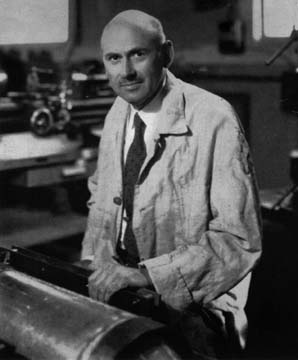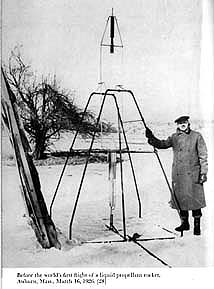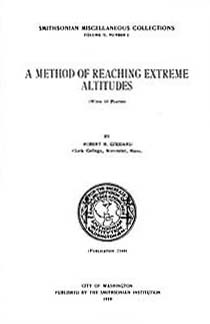
To Open The Sky

An historical essay on the life and work of
Robert Hutchings Goddard
The Father of American Rocketry
It is often said that a prophet is without honor in his own land.
Will Rogers put it another way:
"The fellow that can see a week ahead is always the popular fellow, for he is looking with the crowd. But the one that can see years ahead, he has a telescope, but he can't make anybody believe he has it."
Part 1: The Cherry-Tree Dream
Robert Goddard was one such visionary. He was born in the industrial city of Worcester, Massachusetts on October 5th of 1882, the ninth generation of a family notable for its achievements. His father was said to have Yankee ingenuity with machinery and tools. The elder Goddard moved the family to Boston during his son's infancy to take up half-ownership of a machine-tools shop. Here Goddard spent his youth, an only child in a home with an invalid mother suffering from tuberculosis. He himself was often sickly, and his schooling was seriously impeded as a result.
Robert was seventeen when the family returned to Worcester. He had then completed only the freshman year of high school, demonstrating mediocre scholarship and a pronounced distaste for mathematics. Illness kept him out of school entirely that autumn of 1899. But his mind was not idle. His father had given him a subscription to Scientific American, which he devoured avidly each month. He made good use of the local library, reading books on science as well as science fiction — most notably H. G. Wells' War of the Worlds, a novel he revisited often in later years.
He was allowed some outdoor chores, and on the nineteenth day of October he clambered up into an old cherry tree in the orchard to prune some dead limbs. It was a fine day, and as he gazed over the country a vision came to him that was to determine the whole course of his life. He recorded the event in his diary:
"As I looked toward the fields in the east I imagined how wonderful it would be to make some device which had even the possibility of ascending to Mars, and how it would look on a small scale if sent up from the meadow at my feet . . . It seemed to me that a weight whirling around a horizontal shaft, moving more rapidly above than below, could furnish lift by virtue of the greater centrifugal force at the top of the path. I was a different boy when I descended the tree from when I ascended, for existence at last seemed very purposive." [1]
The linear-force-from-eccentric-rotation idea has surfaced again and again, perhaps most recently in the form of the Dean Drive. Alas, it is pure fantasy. But though Goddard never talked much about this daydream of his 17th autumn, it is clear he was not deluded for long. His arboreal inspiration led him to a life of experimentation that was dedicated to producing results. While he abandoned that original method as useless, the dream of soaring into space never left him, and throughout his life he quietly celebrated its birth each October 19th.
In order to realize that dream, he knew, he had to complete his education — and that meant mathematics. It was two full years before he was well enough to continue. He entered South High School in Worcester as a sophomore. He was determined to "shine" in mathematics and physics, but it was still a struggle. Sources variously credit Calvin C. Andrews and a Miss Hill, teachers of physics and math respectively, as helping him "over the hump" in his studies. He graduated in 1904 with high scholastic honors, the oldest student ever to receive a diploma from South High. His commencement address, On Taking Things for Granted, closed with these words:
"It is difficult to say what is impossible, for the dream of yesterday is the hope of today, and the reality of tomorrow."
Things did not improve immediately for Robert Goddard. His mother needed constant care, which was a significant drain on the family's time and money. However, he had a remarkable grandmother who saw to it that a scholarship and other financial help enabled him to attend Worcester Polytechnic Institute. There, he continued his record of excellent scholarship, with Professor A. Wilmer Duff providing the inspiration in physics.
Despite his brilliance and a rather tall, gangly appearance, Goddard was no bookworm (or "nerd", as we say today.) Sociable and witty, he took part in many activities including the tutoring of backward students in mathematics. In his senior year, he was elected class president and served as editor-in-chief of the college yearbook. With a degree from WPI in hand, he entered doctoral studies at Clark University, also in Worcester, while teaching at the Institute.
During this time he also began small-scale experiments with rockets, developing his ideas for multi-stage rockets which would use hydrogen and oxygen as propellants to reach space. He earned his Ph.D. from Clark in 1911, put in another year of study there, then moved to Princeton University's Palmer Physical Laboratory on a research fellowship. While completing his assigned work there — an esoteric project involving measurement of forces in a dielectric carrying displacement current — he spent many long nights working until dawn to master the mathematical basis of multi-stage flight.
This exhausting schedule took a toll on his health. By the spring of 1913 he was forced to consult a physician. The diagnosis: tuberculosis was far advanced. He was told he had two weeks to live.
Bed rest was prescribed, with a strict order to limit his workload. It was touch and go for quite a while, but eventually his health began to return. Nurses would find papers covered with equations and notes beneath his pillow. But Goddard was careful not to overdo it. He knew — and said — that he could not die with his work unfinished.
Progress continued. In October of 1913 he applied for his first patent on rocket propulsion. A second application came in May 1914. Goddard resumed part-time work on the physics faculty at Clark University in the fall of 1914. By that time, his first two patents had issued. They antedate all other patents in the field of rocketry. Goddard's portfolio of patents ultimately reached 214. The last was granted eleven years after his death.
Steadily improving health permitted Goddard to scale up his experiments. He was working at this time with solid-fuel rockets, because his funds were quite limited. But it was the liquid-fueled variety for which he held high hopes, as a result of his earlier theoretical analysis. What was needed was venture capital. He wrote a detailed memorandum describing his theories, giving it the sober title "A Method of Reaching Extreme Altitudes," and sent copies to several scientific institutions in the hope of attracting some funding.
Today this paper is recognized as one of the foundation documents of astronautics. In 1916, however, it was passed over lightly by most of the institutions that reviewed it. But not, fortunately, by the Smithsonian. Assistant Secretary Dr. Charles Abbot, an astrophysicist, carefully checked Goddard's mathematics and recommended approval. An expert at the National Bureau of Standards concurred. A letter was sent to Goddard asking how much he thought his rocket would cost to develop. His estimate was $10,000, but he modestly asked for only half that much. This lower sum was granted, and a check for $1,000 was quickly supplied, allowing development of a prototype to get under way. In all, the Smithsonian contributed $12,500 to Goddard's efforts. They contributed in other ways, too. When the U.S. entered World War I in 1917, they advised the Army Signal Corps to enlist Dr. Goddard's help in producing rockets useful in battle. The Army listened; such weapons were built, and a demonstration at Aberdeen Proving Grounds on 10 November 1918 impressed the brass. But the Armistice was signed a few days later, putting an end to any talk of production. Goddard's military work was forgotten for twenty years, to be revived at the onset of World War II and turned into the bazooka.
First Liquid-fuel Rocket Flight

Goddard returned to Clark in 1918 and was promoted to a full professorship in the physics department. He resumed his experiments in Worcester. Solid-fuel chemistry was primitive then; the only real choice was smokeless powder. Goddard made improvements that greatly increased the efficiency of his motors; but this got him no closer to a working multi-stage design. For a number of years he concentrated on perfecting a mechanism to inject powder cartridges into the firing chamber; but this proved too complicated and prone to failure. By 1923 [2] his machinists were fabricating components for miniature liquid-fuel motors. This was proof-of-principle work; the devices were too tiny to be worth flying. The first bench test of a larger motor happened on 6 December 1925. A steel framework to support this motor was built, and on 16 March 1926 came the historic first flight of a liquid-fuel rocket when this ungainly assemblage lifted itself 41 feet at Pakachoag Hill near Auburn, Massachusetts.1

This period in Goddard's life is also noteworthy for the scorn heaped upon his head by ignorant writers for newspapers and magazines. It began this way: Clark University's physics department was headed at that time by a Dr. Webster, a man of strong opinions. He had earlier questioned the worth of Goddard's rocket work. But now he demanded more publication of results. When the secretive inventor demurred, Webster threatened to handle the matter himself. Choosing the less objectionable course, Goddard asked the Smithsonian to publish his "Extreme Altitudes" paper. They did so late in 1919, and this brought a spate of derisive opinion pieces. Perhaps the most notorious example is the New York Times editorial of 13 January 1920. Goddard first tried to explain his work to these nay-sayers, but never got through; he ultimately learned to ignore such baseless attacks.
Publication brought notice from other countries as well. But this notice was of an altogether different character — admiring rather than deriding. Nevertheless, Goddard seldom offered any information. It was not long before battles over priority began.
Goddard a Public Menace
Dr. Abbot, now Secretary of the Smithsonian, pushed Goddard for higher altitudes in his experiments. Meanwhile, the good citizens of Worcester began to object to Goddard's increasingly noisy flight tests. After a test on 17 July 1926, someone thought an airplane had crashed. Police cars and an ambulance rushed to the test site, accompanied by a couple of reporters — to find nothing amiss. But Goddard and his crew were still there salvaging valuable, hand-tooled pieces of the crashed rocket. Questions flew. The professor explained as best he could. Predictably, the local press had a field day with the story. Just as predictably, unwanted sightseers began to show up for every test. It was not long before the state Fire Marshall ordered Goddard to remove his rocket activities from the Commonwealth of Massachusetts.
Dr. Goddard sought a new location out of state jurisdiction, and by 1929 had moved to an abandoned artillery range on Camp Devens, a federal property. At the end of a bumpy dirt road, about 25 miles from Worcester, he set up his tower again by a stagnant pool called Hell Pond. This secluded site was fine for static tests; but flight vehicles could not stand the rough trip, and the travel times prevented accomplishing a test in one day, as Goddard's teaching load required. Also, his Smithsonian funds were nearly gone.
Clearly, further progress depended on three things: more funding; freedom from other duties; and plenty of room for rocket flights. Funding had to come first.
On a dreary afternoon in November 1929, having ended his last class for the day, Goddard sat at his desk planning the following day's run at Camp Devens. He received an unanticipated phone call. At home, he mentioned it to his wife:
"Esther," Goddard began, unfolding his napkin at supper that evening, "I had an interesting call from Charles Lindbergh."
"Of course, Bob," his wife replied airily. "And I had tea with Marie, the Queen of Rumania." [3]
"Lucky Lindy" was then at the peak of fame for his solo flight across the Atlantic, and eager to foster new achievements. Aware that propellers were pointless in space, Lindbergh had asked experts at M.I.T. to tell him who in America knew most about rockets. The answer led him to the headquarters of E. I. Du Pont de Nemours in Wilmington, Delaware. There, all doors were open to him — but the minds he met were not. DuPont's experts regarded the extreme heat and huge fuel consumption of rocket engines as insoluble problems. A few weeks later, news of Dr. Goddard's July 1929 difficulties reached him through a story in the New York Times. After meeting the inventor, he determined to help arrange financial support if possible.
Lindbergh brought Goddard to Wilmington to visit Henry Du Pont and his staff. The DuPont engineers questioned their guest closely about methods, and began to take notes. Goddard, immediately suspicious, clammed up.
Lindbergh's next attempt was to arrange a conference with the Advisory Committee of the Carnegie Institution in Washington, DC. This was held December 10, 1929 at the home of Dr. John C. Merriam, the Carnegie president. Facing a group of distinguished scientists including the Smithsonian's Abbot, Dr. Goddard felt at ease and met respect for his ideas. When the discussion turned to money, Goddard estimated a need for $100,000 over four years. Others felt that reaching high altitudes called for even more massive expenditures. Merriam offered to recommend a grant of $5,000 and asked how Goddard would like it disbursed. The professor replied, "$500 at a time, and when that's used up, I'll send you the vouchers." [4] Recognizing Goddard's thrifty, incremental style, Merriam felt he might do more with the $5,000 than others expected. This funding was eventually granted, and it helped Goddard set up shop in the wide-open spaces of the West.
A financier, Lindbergh realized, was the only real hope for funding of the amounts required. Before his transatlantic crossing, the aviator had met Harry Guggenheim, formerly a Navy flyer in World War I. Guggenheim interested his father, philanthropist Daniel Guggenheim, in supporting aviation, and the elder Guggenheim created the Guggenheim Fund for the Promotion of Aeronautics. Lindbergh was influential in persuading him to give Goddard a generous two-year grant of $50,000 beginning in July 1930, after Goddard's Smithsonian funds ran out in the spring.
From Hell Pond to Eden Valley
The next step was choosing a location. Goddard consulted a meteorologist at Clark. He suggested the plateau of southeastern New Mexico. It was warm, high, dry and sparsely populated. In addition to facilitating rocket testing, these conditions were ideal for those suffering from respiratory problems. On a visit in August 1930, Goddard found Mescalero Ranch, a vacant homestead owned by Effie Olds of the family that had produced the Oldsmobile car. He promptly leased this property three miles from Roswell, a bustling cattle town of some 11,000 souls served by daily runs on the Santa Fe rail line. A further search turned up Oscar White, who offered Eden Valley, an area of about 16,000 acres, for Goddard's launch operations. Asked about rent, the rancher waved the question away. All Goddard had to do, he said, was to follow the "law of the range:" Leave any gates you come to as you found them.
Back in Worcester, Goddard made ready for the move. He had shut down the Camp Devens work, thus preserving most of the $5,000 Carnegie Institution grant. This money went into building and equipping the machine shop at Mescalero Ranch. To a man, his crew had already agreed to join him there. The 60-foot launch tower was packed up and shipped west, along with much equipment from the physics lab at Clark University. President Atwood granted him an extended leave of absence, and Goddard was on his way.
NOTES:
[1] — Yost, p. 145
[2] — I have some doubt about the date for the first, small L-F motors.
[3] — Lehman, p. 159
[4] — Lehman, p. 165
PICTURE CREDITS
Goddard in his Lab — Yost, plate 7B
First flight of L-F rocket — Lehman, picture 28 (ca. p. 174)
Cover of 1919 paper — von Braun & Ordway, p. 46
REFERENCES
| Disclaimer | Claimer |

